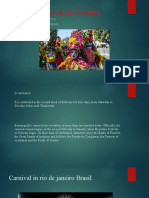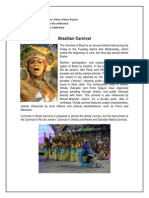-CARNIVALS:
VENICE:
The Carnival of Venice is an annual festival held in Venice, Italy. The
carnival ends with the Christian celebration of Lent, forty days people
dress up in costumes and go out on the streets to stroll and take
pictures, either in organized or improvised parades. The costumes
are Venetian 17th century period costumes, as if they were straight
out of a Canaletto painting.efore Easter, on Carnival Day, one day
before Ash Wednesday.
CHINA
It is the most amazing festival tradition among the Wa people, one of
the 56 Chinese minorities. Celebrated on May 1 and 2 in Yunnan, it
is an ancient tradition of exercising while wearing a kind of healthy
paste on the face and body. The Monihei Carnival in China is all about
having fun getting dirty with mud. The word "Monihei" in Chinese
translates as "getting black, smearing something on your body". The
Monihei Carnival is all about getting completely covered in mud in a
fun pitched battle
�BARRANQUILLA
This Carnival is a place of encounter and expression of the symbolism
of the daily life of the Colombian Caribbean man, it fulfills the cultural
function of allowing the reaffirmation of the collective and individual
identity, through the assimilation of new forms of expression framed
in universal cultural codes. According to the mayor's office of
Barranquilla this is a party of "European origin". The carnival
celebrations would have been introduced to the country by the
Spanish and Portuguese who came to "La Arenosa".
BRAZIL
The roots of the Rio Carnival are in the Catholic traditions of Brazil,
when the first Rio Carnival dance was held in 1840 and participants
danced polkas and waltzes, a very different tradition from the popular
samba, which was introduced in 1917. The main celebrations take
place in Rio de Janeiro, Salvador de Bahia, Recife/Olinda and São
Paulo, where samba schools, blocos and bands occupy entire
neighborhoods. Some of them are: In Rio de Janeiro.
�Medellín flower festival
The Flower Fair is the most important event in Medellin, as it
embodies all the values of the people of Antioquia. The fair lasts 10
days and is part of the Colombian cultural heritage.
The parade of silleteros, the central act of the fair, originated thanks
to the invitation that Arturo Uribe Arango, from the Office of
Development and Tourism of Medellin, made to 40 silleteros from
Santa Elena (Antioquia) to decorate the first version of the fair in 1957.
Adriana Lucia Rojas Valderrama.

























































